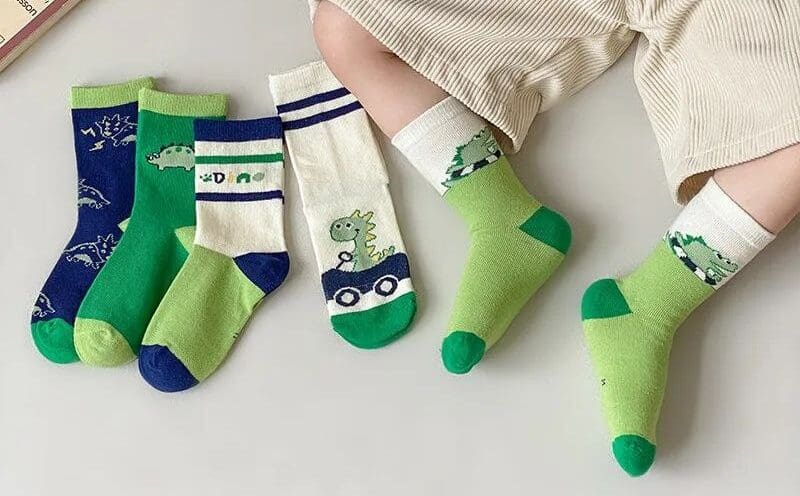In the realm of fashion, socks play an underrated yet pivotal role. Not only do they offer protection for our feet, but they also become an essential element of our style. The increasing trend towards colorful socks has ushered in a need to understand the best materials that balance comfort with vividness. Let’s embark on a journey to explore the top materials and appreciate their care requirements.
The Importance of Material Choice in Colorful Socks
Before diving into the specific materials, it’s worth noting why they are paramount. Durability, comfort, color retention, and elasticity hinge on the material’s quality. Making an informed choice guarantees socks that feel luxurious, withstand time, and retain their color brilliance.
Cotton Socks: An Evergreen Favorite
Natural cotton is a staple in sock production due to its multiple advantages:
- Breathability: Perfect for summery days and less intense activities.
- Softness: With each wash, they tend to feel even softer.
- Color Longevity: Premium cotton holds dye remarkably, ensuring lasting vibrancy.
Blending cotton with synthetic fibers for durability can offer strength without compromising comfort.
Merino Wool Socks: The Chilly Season’s Best Friend
Merino wool serves beyond winter apparel, providing multiple benefits for sock wearers:
- Temperature Regulation: Exceptional in keeping feet warm in cold climates and cool during warmer months.
- Moisture Absorption: Effective in preventing sweaty feet.
- Natural Stretch: Offers a perfect fit without constriction.
- Color Depth: Its absorbent nature means richer, lasting colors.
Bamboo Socks: The Green Choice
Bamboo emerges as an environment-friendly option, presenting several merits:
- Sustainability: Rapid growth and minimalistic requirements make bamboo a green choice.
- Antibacterial: Naturally combats bacteria, ensuring fresher feet.
- Silken Comfort: Its fibers are plush, offering unmatched solace.
- Color Brilliance: Holds dye exceptionally, promising persistent hues.
Synthetic Fabrics Socks: Champions of Longevity
Blends of nylon, spandex, and polyester with natural counterparts promise enhanced endurance:
- Increased Lifespan: Render socks are more resistant to daily wear.
- Shape Retention: Ensures they maintain their form, even after multiple launderings.
- Enhanced Vibrancy: Augments color intensity.
Silk Socks: The Touch of Opulence
For those leaning toward luxury, silk socks are unbeatable:
- Natural Luster: Silk’s innate shimmer is unparalleled.
- Cooling Effect: Makes them suitable for high-end events.
- Rich Color Palette: Its interaction with dyes results in deep, unique shades.
Combination Caveats Socks
While blending materials often yields superior-quality socks, certain combinations might be less effective. Cotton and silk, for example, can result in reduced durability as both are delicate materials. Such blends might also compromise moisture-wicking capabilities.
Sock Care According to Material
- Cotton: Machine wash in warm water. Avoid bleach to retain color vibrancy.
- Merino Wool: Preferably hand wash in cold water. Lay flat to dry to retain shape.
- Bamboo: Machine wash on a gentle cycle with cold water. Tumble dry on low.
- Synthetics: Machine wash with similar colors. Avoid high heat when drying.
- Silk: Hand wash with mild detergent. Avoid wringing and lay flat to dry.
Final Thoughts: The Perfect Blend
The best colorful socks often result from a blend of the above materials. Understanding each material’s unique strengths ensures feet stay both trendy and comfortable. Always remember the design captures the eye, but the material captivates the foot.
FAQ
What are the best materials for crafting colorful socks?
Cotton is a popular choice for colorful socks because of its comfort and durability. Wool is another top pick, especially for colder climates, as it provides warmth. For sports or activities, synthetic materials like polyester and nylon are preferred for their moisture-wicking properties. Remember, the brighter and more vibrant the colors, the more important it is to choose high-quality materials to prevent fading.
How do different materials affect the vibrancy of colors on socks?
Cotton typically holds dye well, resulting in bright and vivid colors. Wool, while warm and comfortable, might not be as vibrant as cotton because of its natural fibers. Synthetics like polyester and nylon can be made into very bright colors due to their production process. Over time, however, the type of material and the washing process will impact color retention.
Are there specific materials that are best for certain colors?
Not necessarily specific to colors, but the dyeing process can vary based on the material. For example, cotton works well with both natural and synthetic dyes. Synthetics like polyester often require specialized dyes to achieve the most vibrant colors.
How do I care for colorful socks to maintain their vibrancy?
Always follow the care instructions on the label. Generally, washing colorful socks in cold water with mild detergent and air drying will help maintain their colors. Avoiding bleach and harsh chemicals is crucial to preventing fading.
Why might some materials cause irritation when used for socks?
Materials like wool can sometimes cause irritation for those with sensitive skin or allergies. On the other hand, synthetic materials might not breathe as well as natural fibers, leading to sweating or discomfort. It’s essential to find the right balance between comfort and function.
How does material thickness impact sock comfort?
The thickness of the material can affect both warmth and cushioning. Thick wool socks are perfect for cold winters, providing insulation. Thin cotton or synthetic socks might be more suitable for summer or athletic activities. Always consider the purpose of the sock when choosing a material.
Are there sustainable or eco-friendly materials for colorful socks?
Yes, organic cotton, bamboo, and even recycled polyester are becoming popular choices for those looking for sustainable sock options. These materials have a lower environmental impact while still providing the comfort and vibrancy sock wearers seek.
Can I mix materials to get the best of both worlds in colorful socks?
Absolutely! Many socks blend materials to optimize comfort, durability, and color retention. For example, a cotton-polyester blend can provide the softness of cotton with the moisture-wicking properties of polyester.













